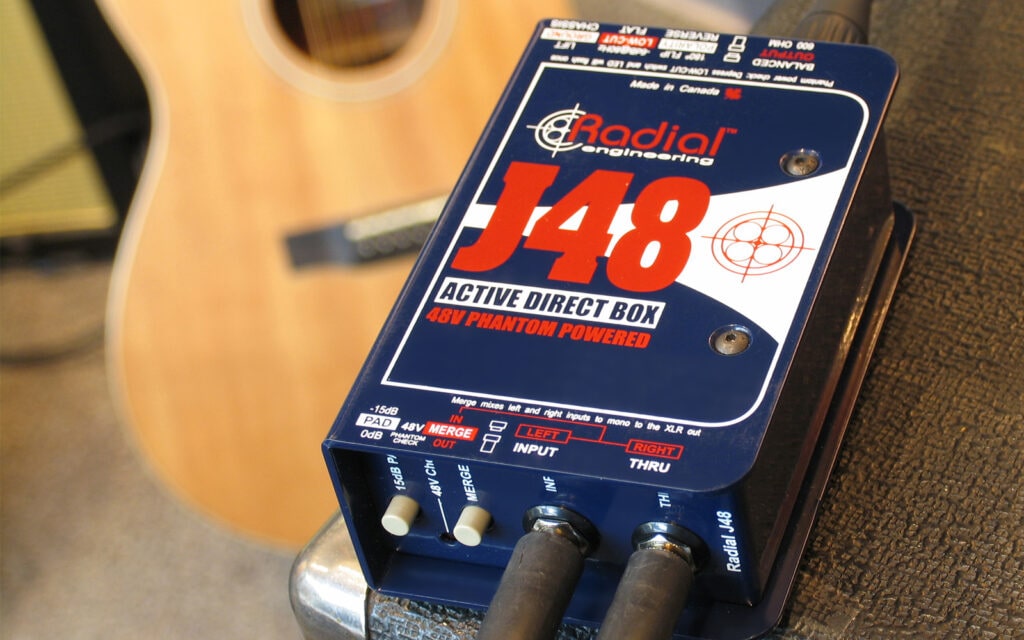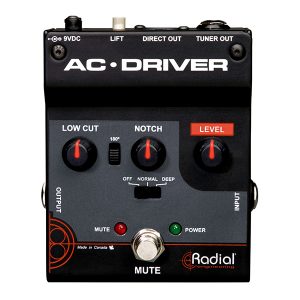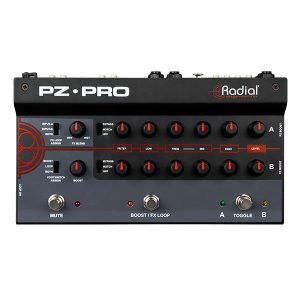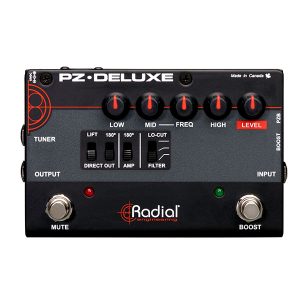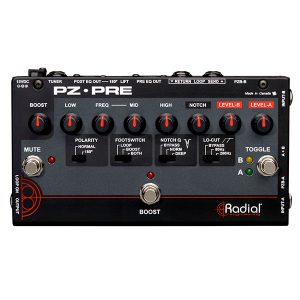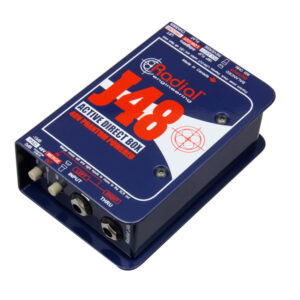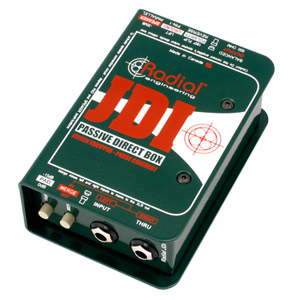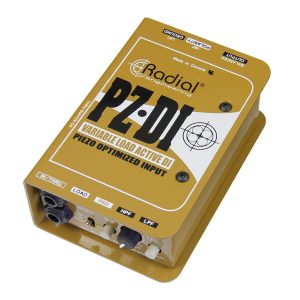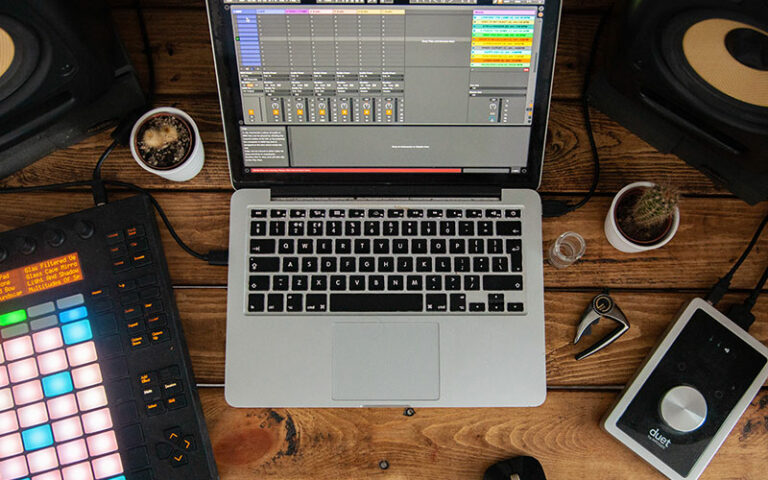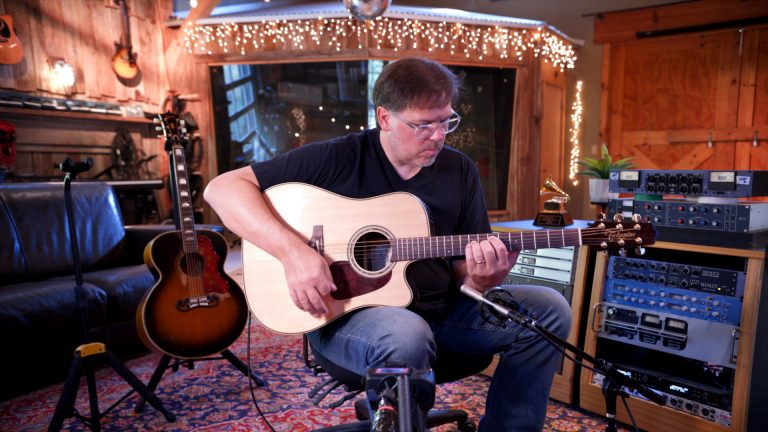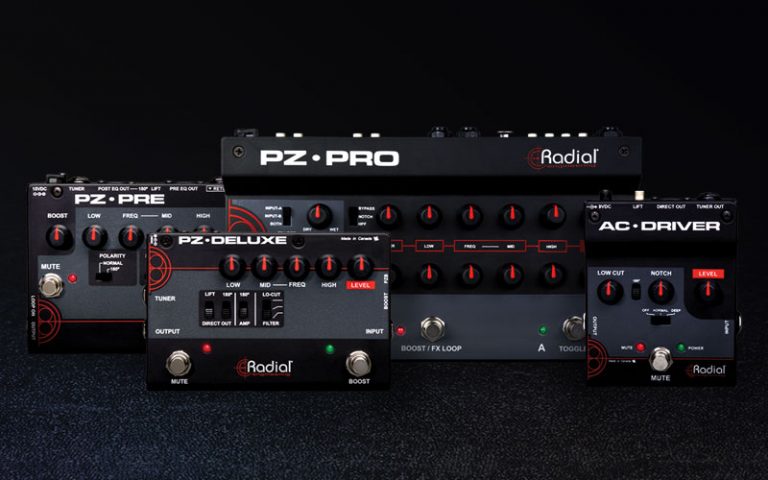If you’re frustrated with the sound of your acoustic pickups, you’re not alone. Though there are really only three main types of pickups used on acoustic guitar, they all excel at some things and struggle at others. This leaves many of us searching for very elusive tonal answers.
If this is you, you’ve come to the right place. We’re going to look at the different acoustic pickup options available, as well as the preamp and direct boxes that pair best with each type. We hope this will help you understand how your pickup type affect the tone of your guitar, and give you some advice that will have your instrument sounding at its best.
Three types of acoustic pickups
- Piezo
- Magnetic
- Microphone
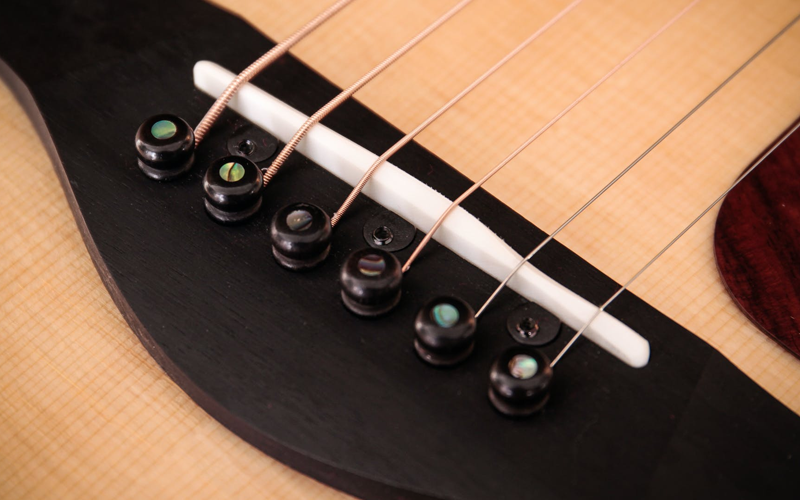
Piezo
Pros: Feedback resistant, broad frequency spectrum
Cons: Sterile, unnatural tone
Piezo-electric (or simply piezo) pickups are the most used acoustic guitar pickups on the market. By utilizing piezo-electric crystals in a thin strip located under your guitar’s bridge saddle, they sense the vibrations of the guitar top.
The reason piezo pickups are so popular is their inherent ability to reject feedback at loud levels. They also have a full frequency response and a low-profile design. But they do have one major drawback…
The dreaded piezo “quack.”
Piezo “quack” refers to the sterile, plastic-sounding, and unnatural tone that piezo pickups produce. While it may sound ok in a loud rock mix, it is the bane of many solo-guitarists’ existence. It is also tough to EQ out, leaving many acoustic guitarists accepting the sound as a compromise for the feedback control their performances require.

Magnetic Pickups
Pros: Easy to use; feedback resistant
Cons: Magnetic pickup tone; a bit unsightly
Though we often associate magnetic guitar pickups with electric guitars, the fact is, before magnetic pickups, every guitar was an acoustic guitar. Therefore, magnetic pickups were the first method for amplifying acoustic guitars.
Today there are countless magnetic acoustic guitar pickups still on the market. And their construction is very similar to that of their electric-guitar counterparts. They’re constructed with a copper coil of wire around a bobbin, a magnet, and some lead wire.
Acoustic guitar magnetic pickups usually mount in your guitar’s soundhole. Like piezo pickups, acoustic guitar magnetic pickups are excellent at resisting feedback at higher volumes. And while they don’t have piezo “quack,” they do have their own not-quite-natural acoustic tonality. Also, magnetic pickups take a bit away from an acoustic guitar’s natural beauty because of their larger design and soundhole placement.

Microphone
Pros: Great, natural tone; ideal for blending with piezo or magnetic pickups
Cons: Hard to control; prone to feedback
Rounding out this trio of acoustic guitar pickup options are microphone-based designs. Actually, it’s hard to call these products pickups at all. They are actual microphones, after all. But because they are microphones, they are far and away the most natural way to amplify the woody tone of your acoustic guitar. From capturing its tonal nuance to perfectly translating body percussion, these “pickups” are the closest you can get to that “mic’d in a studio” tone.
Microphone pickups are available in many different configurations. From lavalier-style mics that sit inside the soundbox to condenser microphones built into magnetic pickups (more on that in a minute), it’s easy to get a great-sounding mic in your guitar.
“If they’re so great, why doesn’t everyone use them?”
Because as good as they sound, they can be challenging to control. You see, like mic’ing an acoustic guitar the traditional way, once the volume goes up, the speaker, mic, and guitar top combine their energy into a show-stopping feedback howl. And once you put a microphone inside a guitar, it’s like cupping a mic with your hand. You’re inviting the feedback at that point.
Tonal Solutions to These Problems
Though each of these pickups sports frustrating characteristics, there are a wide variety of great-sounding solutions on the market to remedy each.
- Combination systems
- Onboard preamps
- External preamplifiers and the Radial Acoustic Series
- Effects designed for acoustic guitar
Combination pickup systems
Combination pickup systems are any acoustic guitar pickup that features two or more of the above pickup types. Whether it’s piezo and mic, mic and magnetic, or magnetic and piezo, by pairing them together, you amplify each’s strengths while minimizing their flaws.
A great example is the piezo/microphone combination. If you play acoustic guitar in a loud band, a mic by itself will never cut it. But get your volume from the piezo pickup and blend in a bit of the mic sound for warmth and detail, and you’ll never go back.
Many magnetic pickups, such as the Seymour Duncan Mag Mic, put both magnetic and mic pickups into a single, easy-to-install unit. For instruments that have two pickups systems installed but no way to blend them, or if you have a pickup system that you want to combine with an external or clip-on microphone, there are several outboard preamp options that can help with this – see the section below for more details.

Onboard preamps
Every acoustic guitar pickup requires some form of preamplifier to strengthen and shape the sound. That’s why most acoustic-electric guitar manufacturers offer instruments with the preamps mounted right onboard. If you’ve ever seen an acoustic with EQ, volume, and tuner controls on the side, that’s exactly what we’re talking about.
These onboard preamps are an excellent solution for putting tonal sculpting, dynamic, and feedback control right at the player’s fingertips. Some even go as far as including acoustic guitar imaging right into the guitar itself.
While they won’t make your piezo pickup sound like a microphone, onboard acoustic guitar preamps do let you shape your sound without the need for external devices.
External preamplifiers and the Radial Acoustic Series
Onboard preamps can get the job done. But due to their size and construction limitations, many acoustic guitarists prefer to use a high-quality external preamplifier. Often found in pedal format, the space constraints of onboard designs don’t limit external preamps. Therefore they often boast an expanded variety of features to tweak your live acoustic tone with precision.
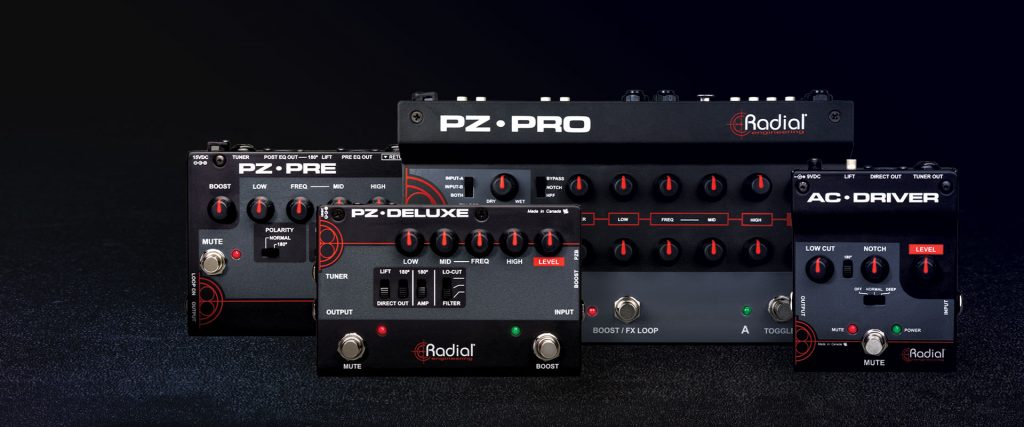
The Radial Acoustic Series
The Radial Acoustic Series of preamp pedals are perfect examples. From the straightforward options found in our AC-Driver to the feature-rich PZ-Pro, they have all of the control that makes preamp pedals so popular. These features include high-pass filters, feedback control, custom-voiced EQ, dual-channel designs, blending of multiple inputs, and much more. You’ll even find a foot-switchable boost in the PZ-Deluxe a sweepable notch filter in the PZ-Pre, and an onboard Radial direct box built into each and every pedal in the Acoustic Series.
External preamps can also offer the same benefits that combination pickup systems do, even if your instrument only has one pickup type installed. The PZ-Pro has a separate microphone input that can be blended with any pickup type, so you can use a clip-on mic or even a large diaphragm condenser microphone and seamlessly balance it with your onboard pickup for studio-quality results. The PZ-Pre also gives you the ability to blend two inputs together at once, so if your instrument has multiple pickup types but no way of combining them you can accomplish this feat using the pedal.
If you’re a performing acoustic guitarist who wants precise and instant control of your plugged-in tone, external, pedal-based preamps are the way to go.
Effects Designed for Acoustic Guitar
Another great way to add some life to a less-than-desirable acoustic-electric tone is with a touch of effects. From reverbs to compression, chorus to delay, adding just a bit is often the difference between a great playing experience and an uninspiring tone. Many of the Acoustic Series Preamps come equipped with an Effects Loop that allows you to blend in your favorite effect while keeping the natural tone of your acoustic.
Many effects pedals today are of excellent quality and can be used with acoustic-electric guitars without a problem. That’s especially true of modern digital effects. But there are some incredible options out there that are custom-voiced for the needs of the acoustic player.
And don’t forget about compression. With a moderate setting, compression can restore natural dynamics and harmonics to an otherwise dead-sounding acoustic pickup.
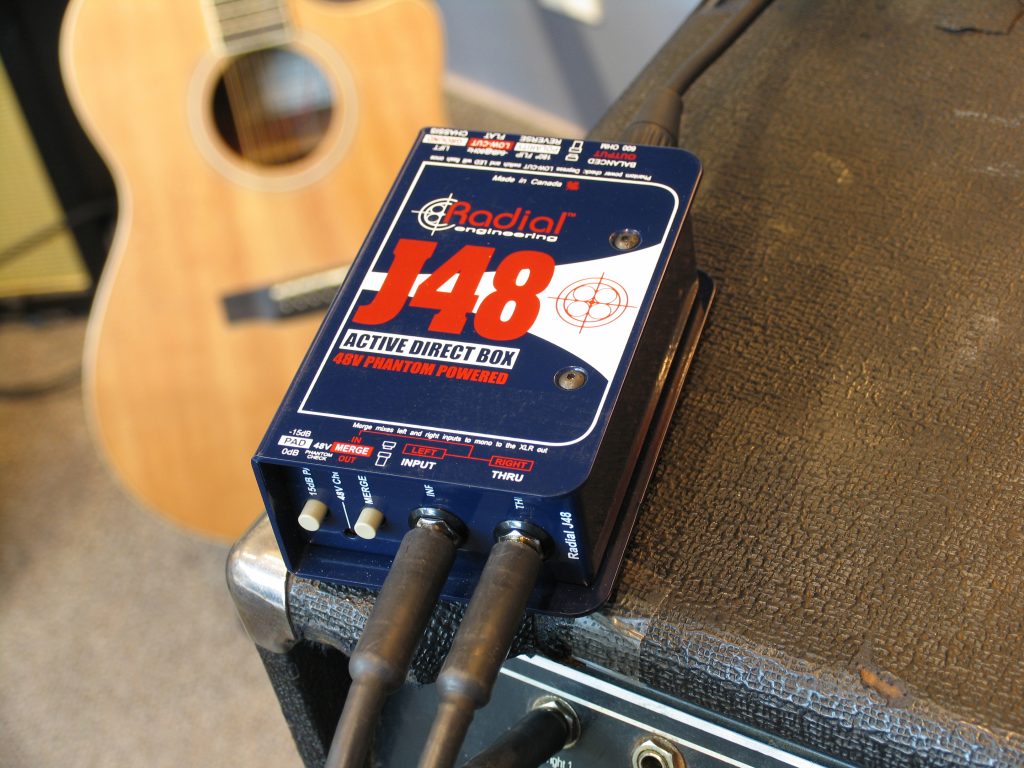
Choosing the right direct box for your pickup system
If you select any of the Acoustic Series pedals, you won’t have to worry about an additional direct box, as they all have one built-in to the pedal to deliver your tone to the PA cleanly.
However, if you don’t utilize one of these pedals in your setup, we still have you covered. Radial offers a ton of industry-standard DI boxes that deliver premier performance in both live and studio applications. Whether you choose our active JD48 or passive JDI, you’ll have reliable transmission of your acoustic pickup’s tone.
J48 / Active Direct Boxes
Active direct boxes like the J48 are perfect for acoustic guitarists who run a simple setup. If you prefer to send your magnetic pickup signal to the house sans preamp, this is the DI for you. Powered by 48v phantom power, it provides an incredibly accurate reproduction of the tone of your guitar, balances it, and sends it out a low-Z output, precisely what a console wants to see.
JDI / Passive Direct Boxes
For players who use an onboard or external preamp to handle the heavy lifting, and for those who use pedal effects in their signal chain, we recommend a passive direct box like the JDI, equipped with a premium Jensen transformer. The JDI’s passive design is perfect for accepting the signal from effects pedals or your powered preamp without clipping or distortion. Even when it is pushed with hot outputs from your preamp, the transformer inside saturates the sound with warm even-order harmonics instead of square wave distortion. From there, it’s converted to a Low-Z, balanced signal, and sent out.
PZ-DI / Direct Boxes with ultra-high input impedance
While the J48 and JDI DI boxes are all-around workhorses in our industry, the Radial PZ-DI is purpose-built for the needs of acoustic-electric players. It features an ultra-high input impedance option that smooths out the sound of a piezo pickup (when it isn’t paired with an onboard preamp). Not only does its active circuitry mimic the pristine performance of our J48, but the PZ-DI also features some acoustic-friendly additions. For instance, the onboard Hi-cut and variable low-cut filters are great for removing boomy low end or aggressive treble. And the PZ-DI’s 3-way input impedance selector optimizes it for any pickup type, including onboard preamps.
Making the most of your acoustic pickup system
As you can see, there are many acoustic pickup options out there for the performing guitarist. And because of the particularities of acoustic guitars, amplifying them can be a steep learning curve. But those particularities are also why we love the instrument.
Hopefully, this guide to acoustic guitar pickups and processing has helped clear some of the air. Whether you wish to plug a piezo-equipped guitar straight into a DI or prefer a microphone/magnetic pickup combo and external preamp pedal, a great plugged-in tone awaits.
If you need help getting the best sound from your acoustic pickup, drop us a line at support@radialeng.com. We look forward to hearing from you.
And don’t forget to keep checking our blog for a lot more useful info, tips and tricks, in-depth tech dives, and more.

